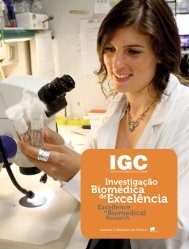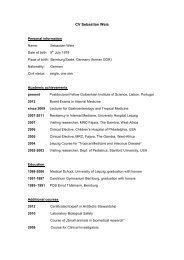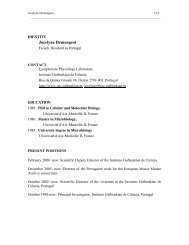organisation - the Instituto Gulbenkian de Ciência
organisation - the Instituto Gulbenkian de Ciência
organisation - the Instituto Gulbenkian de Ciência
- No tags were found...
Create successful ePaper yourself
Turn your PDF publications into a flip-book with our unique Google optimized e-Paper software.
of ca. 30 candidate genes for expression analysis. For <strong>the</strong> latter, we have <strong>de</strong>signed<br />
primers and probes and started optimizing semi-quantitative PCR and in<br />
situ hybridisation protocols for analysis of levels and spatial patterns of gene<br />
expression, respectively.<br />
COPING WITH CHANGING ENVIRONMENTS:<br />
GENETIC AND PHYSIOLOGICAL MECHANISMS OF ADAPTIVE PLASTICITY<br />
Phenotypic plasticity is <strong>the</strong> ability of some genotypes to <strong>de</strong>velop into distinct<br />
phenotypes <strong>de</strong>pending on environmental conditions. Adaptive phenotypic plasticity<br />
leads to a better match between phenotype and selective environment<br />
and can be a solution for <strong>de</strong>aling with fluctuating environments. Many insects<br />
living in such environments have evolved phenotypic plasticity, including seasonal<br />
polyphenisms in butterfly wing patterns. This study investigates <strong>the</strong> proximate<br />
mechanisms (genetic and physiological) behind <strong>de</strong>velopmental plasticity in<br />
butterfly wing patterns, and explores <strong>the</strong>ir potential role in contributing to how<br />
species cope with changing environments.<br />
We analysed <strong>the</strong> data on <strong>the</strong> effects on adult phenotypes (including wing patterns<br />
and body-part allocations) of ecdysteroid manipulations in pupae, and<br />
we started preparing two manuscripts where <strong>the</strong>se results will be reported on<br />
(Mateus et al. in prep; Oostra et al. in prep). We also finished ga<strong>the</strong>ring images<br />
to characterize wing pattern reaction norms for different genetic backgrounds<br />
(to assess genetic-by-environment effects, and <strong>the</strong> role of candidate loci in<br />
plasticity).<br />
EVOLUTION OF CASTE POLYPHENISM IN SOCIAL INSECTS:<br />
PATTERNS OF MORPHOLOGICAL DIVERSIFICATION IN ANTS<br />
Caste <strong>de</strong>termination in ants is a classic example of <strong>de</strong>velopmental plasticity.<br />
Larvae of <strong>the</strong> same genotype can <strong>de</strong>velop into adults with very distinct morphologies,<br />
each adapted for different roles within a colony. Typically, one or a<br />
few larger and winged queens ensure <strong>the</strong> reproductive function, whereas many<br />
wingless workers are responsible for colony maintenance. The <strong>de</strong>velopmental<br />
switch into alternative phenotypes is regulated by larval nutrition, which itself<br />
is un<strong>de</strong>r <strong>the</strong> control of <strong>the</strong> social environment. In collaboration with <strong>the</strong> group<br />
of Christian Peeters in Paris, this project studies how plastic <strong>de</strong>velopmental systems<br />
are regulated, and how <strong>the</strong>y evolve and diversify. Specifically, we want to:<br />
1. Establish a link between caste-specific morphologies and behaviours, in<br />
relation to colony ecology;<br />
2. Characterize <strong>the</strong> environmental regulation of caste <strong>de</strong>velopment.<br />
We analysed <strong>the</strong> data and started to prepare a manuscript (Keller et al. in prep)<br />
on <strong>the</strong> characterisation of caste-specific morphologies and <strong>the</strong>ir correlations<br />
with behaviour (at <strong>the</strong> level of caste-specific roles within a colony, and of reproductive<br />
strategies of whole colonies) for multiple ant species. Roberto Keller<br />
also established new lab populations of <strong>the</strong> ant Aphaenogaster senilis and<br />
established “colony partition” protocols to manipulate frequency of different<br />
sexes and castes produced.<br />
MORPHOLOGICAL DIVERSIFICATION THROUGH THE EVOLUTION<br />
OF DEVELOPMENTAL NETWORKS<br />
The genes that regulate <strong>de</strong>velopment are organized into intricate networks<br />
whose origin and evolution remains a largely unresolved topic. Of great interest<br />
is to what extent <strong>the</strong> different components of such networks contribute to<br />
phenotypic variation and diversification. The evolutionary outcome of changes<br />
on a <strong>de</strong>velopmental network <strong>de</strong>pends on both <strong>the</strong> nature of <strong>the</strong> change and<br />
<strong>the</strong> point in <strong>the</strong> network hierarchy where <strong>the</strong> change occurs. The diversified<br />
eyespot patterns that <strong>de</strong>corate <strong>the</strong> wings of satyrine butterflies offer <strong>the</strong> opportunity<br />
to address <strong>the</strong>se issues. Analysis of cross-species diversity and within-species<br />
variation in wing colour patterns can be integrated with an analysis<br />
of <strong>the</strong> un<strong>de</strong>rlying sequence of <strong>de</strong>velopmental steps and genetic un<strong>de</strong>rpinnings.<br />
Leila Shirai (PhD stu<strong>de</strong>nt) will investigate which type of changes in <strong>the</strong> un<strong>de</strong>rlying<br />
gene networks and respective <strong>de</strong>velopmental mechanisms are responsible<br />
for morphological diversification of this mo<strong>de</strong>l novel trait.<br />
We carried out <strong>the</strong> phylogenetic analysis of <strong>the</strong> recruitment of four conserved<br />
genes for expression in association with <strong>the</strong> early establishment of eyespots and<br />
eyespot-like elements in 13 species. The results of this analysis were prepared<br />
IGC ANNUAL REPORT ‘11<br />
RESEARCH GROUPS<br />
24






